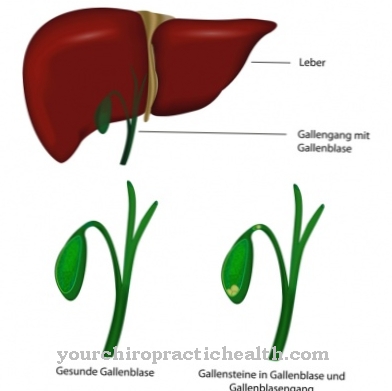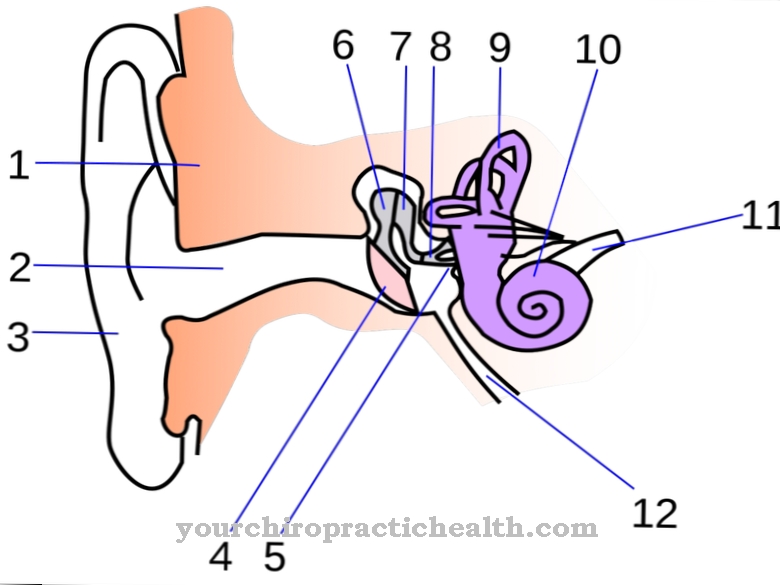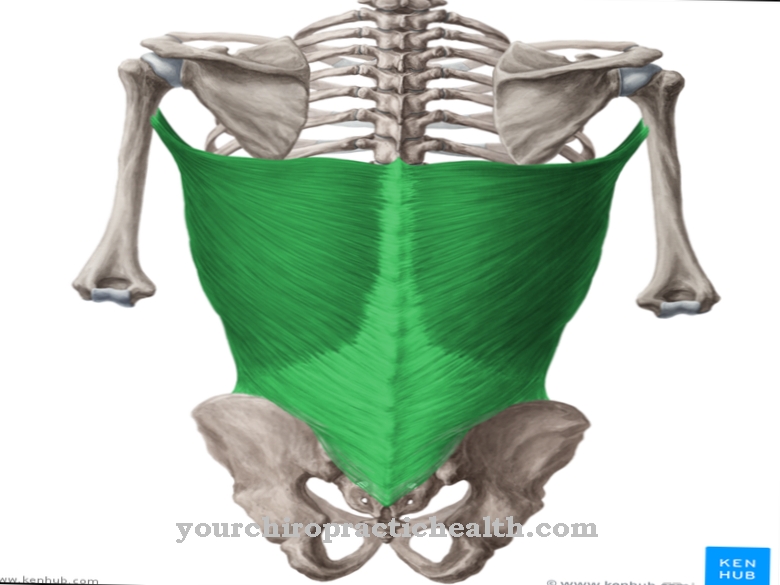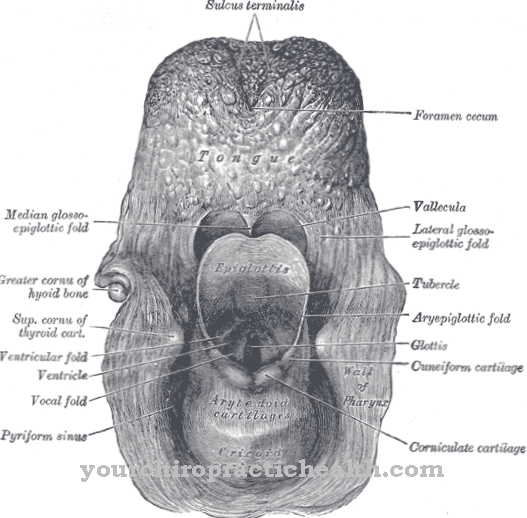As stirrup In ENT medicine and audiometry, one of three connected ossicles in the middle ear is called. The bone, which is reminiscent of a stirrup from equestrian sport, weighs only around 2.5 mg and is the smallest bone in the human body and at the same time the one with the greatest hardness. Its main task is to transmit the vibrations of the eardrum through the oval window to the inner ear.
What is the stirrup?
In the inner ear are the three ossicles, which consist of a hammer (malleus), anvil (incus) and stapes (stapes). As a functional unit, they are responsible for transmitting the vibrations of the eardrum to the oval window, which is the connection to the inner ear. The stirrup, which is reminiscent of a stirrup in equestrian sport, is the last link of the three ossicles.
He sits with his foot on the oval window and transfers his vibrations to the oval window and thus to the perilymph of the inner ear. Due to the anatomy and the articulated connection of the three auditory ossicles, the sound vibrations arriving at the eardrum via air conduction are amplified by a factor of 20 to 30 in order to compensate for the reflection losses that occur when the sound passes from the gaseous medium of air to the liquid medium of perilymph in the inner ear. At the same time, the stapes are able to protect the inner ear from damage caused by loud noises through the stapedius reflex, which is triggered by a sudden rise in the noise level (bang).
Anatomy & structure
With a weight of around 2.5 mg and an average length of 3.3 mm, the stirrup is the smallest, but also the hardest bone in the human skeleton. Its 3.2 square millimeter foot rests against the oval window that forms the flexible connection to the inner ear. The oval window also forms the transition from the gaseous medium air on the side facing the middle ear to the liquid medium perilymph on the side facing the inner ear. The organs of equilibrium and the cochlea of the inner ear are surrounded by the perilymph, while inside they contain endolymph, which is electrolytically different from the perilymph.
With its upper end, the stapes head, the stapes is articulated to the anvil. The stapes are connected to a tiny muscle called the stapedius muscle. If suddenly high sound pressures occur, e.g. B. with a loud bang, the so-called stapedius reflex is triggered. The reflex leads to tension in the smallest striated muscle in the human body and tilts the stapes. As a result, the sound transmission is sensitively reduced, so that there is a kind of overload protection for the inner ear.
Function & tasks
The main task of the stapes, in conjunction with the two other auditory ossicles, anvil and hammer, is to transmit the vibrations of the eardrum in a suitable form to the perilymph in the inner ear. In another function, the stapes protect the sensory cells in the cochlea from sudden overload caused by noises with extremely high sound pressures.
When the vibrations of the eardrum are transmitted to the perilymph, the problem of the phase transition arises. Airborne sound, which is characterized by low sound pressures with high deflections due to the compressibility of the gaseous sound carrier, must be transformed into a form of high sound pressure with low deflections (impedance conversion) in order to do justice to the sound transmission in incompressible liquids. This happens through the articulated connections between the three auditory ossicles using the lever law. The force exerted by the eardrum on the hammer, which absorbs the vibration of the eardrum, is increased by a factor of 90 via mechanical leverage with a corresponding reduction in deflection.
This ensures that the stirrup converts the sound that arrives at the eardrum as airborne sound with almost no loss and is transmitted to the inner ear through the stirrup at the oval window. In order to be able to contribute to the protection of the sensory cells in the cochlea from overload, the efficiency of sound transmission through the stapedius reflex can be reduced. The tiny stapedius muscle, which is connected to the stapes, shortens when the reflex is triggered by a very loud noise (bang) and thereby tilts the stapes, which significantly reduces the efficiency of sound transmission.
You can find your medication here
➔ Medicines for earache and inflammationDiseases
One of the most important and most frequent diseases and complaints related to the function of the stapes is sclerotization of the membrane that holds the stapes foot at the oval window at the transition to the inner ear. This is an ossification, also known as otosclerosis, which leads to a gradually increasing conductive hearing loss because the transmission of sound vibrations to the inner ear is disturbed.
At an advanced stage of the disease, an artificial stapes (stapes prosthesis) can restore hearing to a certain extent using microsurgery. The reasons for the occurrence of otosclerosis are not (yet) sufficiently known and researched. Colds, otitis media, dysfunction of the Eustachian tube and similar diseases can lead to an effusion of the tympanic membrane, fluid accumulation in the middle ear. The liquid can vary in consistency and is prone to inflammation.
The functional chain of sound transmission through the ossicles is mostly disturbed, so that conductive hearing loss occurs in the affected ear, which is reversible if the problem causing it, the tympanic effusion, can be healed. In rare cases, a tympanic effusion can also be caused by a tumor in the nasopharynx, which requires appropriate medication.
Typical & common ear diseases
- Eardrum injuries
- Ear flow (otorrhea)
- Otitis media
- Ear canal inflammation
- Mastoiditis
- Ear furuncle
























.jpg)



